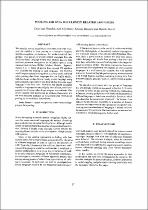JavaScript is disabled for your browser. Some features of this site may not work without it.
- ResearchSpace
- →
- Research Publications/Outputs
- →
- Conference Publications
- →
- View Item
| dc.contributor.author |
Van Heerden, C

|
|
| dc.contributor.author |
Kleynhans, N

|
|
| dc.contributor.author |
Barnard, E

|
|
| dc.contributor.author |
Davel, M

|
|
| dc.date.accessioned | 2012-07-03T15:01:49Z | |
| dc.date.available | 2012-07-03T15:01:49Z | |
| dc.date.issued | 2010-05 | |
| dc.identifier.citation | Van Heerden, C, Kleynhans, N, Barnard, E and Davel, M. Pooling ASR data for closely related languages. Proceedings of the Workshop on Spoken Languages Technologies for Under-Resourced Languages (SLTU 2010), Penang, Malaysia, May 2010 | en_US |
| dc.identifier.isbn | 978-967-5417-75-7 | |
| dc.identifier.uri | http://www.mica.edu.vn/sltu-2010/proceedings/Proceedings%20of%20the%202nd%20International%20Workshop%20on%20Spoken%20Languages%20Technologies%20for%20Under-resourced%20Languages.pdf | |
| dc.identifier.uri | http://hdl.handle.net/10204/5974 | |
| dc.description | Proceedings of the Workshop on Spoken Languages Technologies for Under-Resourced Languages (SLTU 2010), Penang, Malaysia, May 2010 | en_US |
| dc.description.abstract | We describe several experiments that were conducted to assess the viability of data pooling as a means to improve speech-recognition performance for under-resourced languages. Two groups of closely related languages from the Southern Bantu language family were studied, and our tests involved phoneme recognition on telephone speech using standard tied-triphone Hidden Markov Models. Approximately 6 to 11 hours of speech from around 170 speakers was available for training in each language. We find that useful improvements in recognition accuracy can be achieved when pooling data from languages that are highly similar, with two hours of data from a closely related language being approximately equivalent to one hour of data from the target language in the best case. However, the benefit decreases rapidly as languages become slightly more distant, and is also expected to decrease when larger corpora are available. Our results suggest that similarities in triphone frequencies are the most accurate predictor of the performance of language pooling in the conditions studied here. | en_US |
| dc.language.iso | en | en_US |
| dc.publisher | School of Computer Sciences, Universiti Sains Malaysia | en_US |
| dc.subject | Speech recognition | en_US |
| dc.subject | Data pooling | en_US |
| dc.subject | Under-resourced languages | en_US |
| dc.title | Pooling ASR data for closely related languages | en_US |
| dc.type | Conference Presentation | en_US |
| dc.identifier.apacitation | Van Heerden, C., Kleynhans, N., Barnard, E., & Davel, M. (2010). Pooling ASR data for closely related languages. School of Computer Sciences, Universiti Sains Malaysia. http://hdl.handle.net/10204/5974 | en_ZA |
| dc.identifier.chicagocitation | Van Heerden, C, N Kleynhans, E Barnard, and M Davel. "Pooling ASR data for closely related languages." (2010): http://hdl.handle.net/10204/5974 | en_ZA |
| dc.identifier.vancouvercitation | Van Heerden C, Kleynhans N, Barnard E, Davel M, Pooling ASR data for closely related languages; School of Computer Sciences, Universiti Sains Malaysia; 2010. http://hdl.handle.net/10204/5974 . | en_ZA |
| dc.identifier.ris | TY - Conference Presentation AU - Van Heerden, C AU - Kleynhans, N AU - Barnard, E AU - Davel, M AB - We describe several experiments that were conducted to assess the viability of data pooling as a means to improve speech-recognition performance for under-resourced languages. Two groups of closely related languages from the Southern Bantu language family were studied, and our tests involved phoneme recognition on telephone speech using standard tied-triphone Hidden Markov Models. Approximately 6 to 11 hours of speech from around 170 speakers was available for training in each language. We find that useful improvements in recognition accuracy can be achieved when pooling data from languages that are highly similar, with two hours of data from a closely related language being approximately equivalent to one hour of data from the target language in the best case. However, the benefit decreases rapidly as languages become slightly more distant, and is also expected to decrease when larger corpora are available. Our results suggest that similarities in triphone frequencies are the most accurate predictor of the performance of language pooling in the conditions studied here. DA - 2010-05 DB - ResearchSpace DP - CSIR KW - Speech recognition KW - Data pooling KW - Under-resourced languages LK - https://researchspace.csir.co.za PY - 2010 SM - 978-967-5417-75-7 T1 - Pooling ASR data for closely related languages TI - Pooling ASR data for closely related languages UR - http://hdl.handle.net/10204/5974 ER - | en_ZA |






